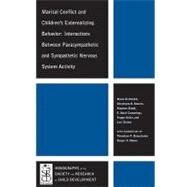Marital Conflict and Children's Externalizing Behavior Interactions Between Parasympathetic and Sympathetic Nervous System Activity
, by El-Sheikh, Mona; Kouros, Chrystyna D.; Erath, Stephen; Cummings, E. Mark; Keller, Peggy; Staton, Lori; Beauchaine, Theodore P.; Moore, Ginger A.- ISBN: 9781405199421 | 1405199423
- Cover: Paperback
- Copyright: 4/28/2009
Toward greater specificity in the prediction of externalizing problems in the context of interparental conflict, interactions between children's parasympathetic and sympathetic nervous system (PNS and SNS) activity were examined as moderators. PNS activity was indexed by respiratory sinus arrhythmia (RSA) and RSA reactivity (RSA-R) to lab challenges. SNS activity was indexed by skin conductance level (SCL) and SCL reactivity (SCL-R) to lab challenges. Moderation hypotheses were examined in three multi-informant studies with children ranging in age between 7 and 9 in Studies 1 and 2, and between 6 and 12 in Study 3. Findings are robust across studies and provide the first reported evidence of interactions between PNS and SNS activity as moderators of the association between children's exposure to marital conflict and externalizing behaviors. More specifically, opposing action of the PNS and SNS (i.e., coactivation and coinhibition) operated as a vulnerability factor for externalizing behavior in the context of marital conflict. Conversely, coordinated action of the PNS and SNS (i.e., reciprocal PNS or SNS activation) operated as a protective factor. Results are supportive of the authors' proposed biopsychosocial framework in which individual differences in the coordination of the activity of the PNS and SNS can function as vulnerability or protective factors in the context of family risk. Findings extend current theory indicating the importance of multisystem investigations for clarifying inconsistencies and discrepancies in the literature linking environmental stress, physiological responses, and child adjustment.







